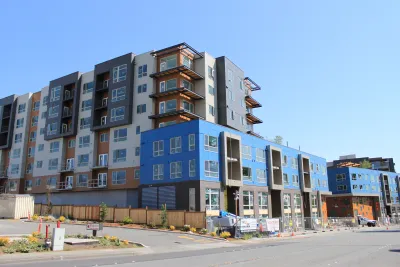Housing underproduction in the United States is growing more severe and more widespread.

The Up for Growth Housing Underproduction™ report for 2022 details the state of housing production in the United States, as well as “practical and tangible solutions” for advocates and policymakers.
According to the report, the nation is short 3.79 million housing units as of 2019, up from 1.65 million in 2012. The shortage is also growing more widespread: while 100 metropolitan areas experienced underproduction in 2012, that number was up to 169 metro areas in 2019. “The extent of underproduction varies from state to state: California has the largest deficit of homes at 980,000, while Mississippi is only short 1,000. Only Vermont saw an improvement.”
The factors impacting housing production are varied: “For example, in Detroit, underproduction is driven by uninhabitable units, while in Sacramento, a lack of housing is driving the shortage. In Washington DC, underproduction is fueled by a lack of household formation,” the report notes.
Even before the pandemic, areas that had not previously experienced housing shortages began to see a deficit. As an article by Emily Badger and Eve Washington in the New York Times puts it, “What once seemed a blue-state coastal problem has increasingly become a national one, with consequences for the quality of life of American families, the health of the national economy and the politics of housing construction.”
To help boost housing production, Up for Growth has developed “a policy framework that seeks to create more homes in areas with high economic mobility, access to jobs, and existing infrastructure” they call A Better Foundation. A Better Foundation “optimizes the distribution of these underproduced homes by prioritizing development in high-opportunity neighborhoods—places that are rich in jobs, transportation, infrastructure, and community assets—at a density scaled to fit into the existing neighborhood while increasing housing options.”
One major step is changing outdated zoning laws that don’t allow for flexibility in density and uses, mandate large lot sizes and parking, and prevent the construction of “missing middle” housing. The full report details the housing types recommended for different types of neighborhoods based on their existing density and strategies for improving equity and affordability.
FULL STORY: Housing Underproduction™ in the U.S. 2022

Analysis: Cybertruck Fatality Rate Far Exceeds That of Ford Pinto
The Tesla Cybertruck was recalled seven times last year.

National Parks Layoffs Will Cause Communities to Lose Billions
Thousands of essential park workers were laid off this week, just before the busy spring break season.

Retro-silient?: America’s First “Eco-burb,” The Woodlands Turns 50
A master-planned community north of Houston offers lessons on green infrastructure and resilient design, but falls short of its founder’s lofty affordability and walkability goals.

Test News Post 1
This is a summary

Analysis: Cybertruck Fatality Rate Far Exceeds That of Ford Pinto
The Tesla Cybertruck was recalled seven times last year.

Test News Headline 46
Test for the image on the front page.
Urban Design for Planners 1: Software Tools
This six-course series explores essential urban design concepts using open source software and equips planners with the tools they need to participate fully in the urban design process.
Planning for Universal Design
Learn the tools for implementing Universal Design in planning regulations.
EMC Planning Group, Inc.
Planetizen
Planetizen
Mpact (formerly Rail~Volution)
Great Falls Development Authority, Inc.
HUDs Office of Policy Development and Research
NYU Wagner Graduate School of Public Service




























